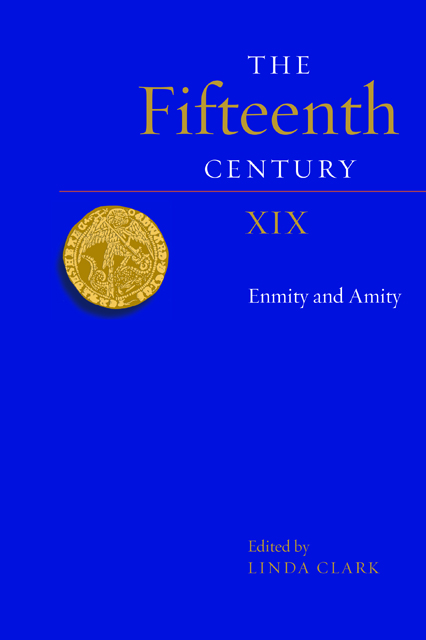Book contents
- Frontmatter
- Contents
- List of Contributors
- Preface
- List of Abbreviations
- England and Europe, c.1450–1520: Nostalgia or New Opportunities?
- Mariners and Marauders: A Case Study of Fowey during the Hundred Years’ War, c.1400–c.1453
- Henry V’s Army of 1417
- ‘Get out of our land, Englishmen’. French Reactions to the English Invasion of 1512–13
- Encountering the ‘Duche’ in Margery Kempe’s Lynn
- ‘C’est le Beaulté de Castille et d’Espaigne, qui le Soleil cler d’Austrice accompaigne’: Jean Molinet makes the Habsburgs Burgundian
- Magna Carta in the Late Middle Ages, c.1320–c.1520
- The Business of the Southern Convocation in 1462
- Index
- Contents of Previous Volumes
- Frontmatter
- Contents
- List of Contributors
- Preface
- List of Abbreviations
- England and Europe, c.1450–1520: Nostalgia or New Opportunities?
- Mariners and Marauders: A Case Study of Fowey during the Hundred Years’ War, c.1400–c.1453
- Henry V’s Army of 1417
- ‘Get out of our land, Englishmen’. French Reactions to the English Invasion of 1512–13
- Encountering the ‘Duche’ in Margery Kempe’s Lynn
- ‘C’est le Beaulté de Castille et d’Espaigne, qui le Soleil cler d’Austrice accompaigne’: Jean Molinet makes the Habsburgs Burgundian
- Magna Carta in the Late Middle Ages, c.1320–c.1520
- The Business of the Southern Convocation in 1462
- Index
- Contents of Previous Volumes
Summary
The Hundred Years’ War loomed large over the first half of the fifteenth century, and its effects and the long continuing hostility between England and France cast their malign shadow far into the sixteenth. Even though the conflict has been pored over by generations of historians, the contemporary record sources which are still extant continue to offer fresh insights and provide evidence that can enhance our understanding of the events: military successes and failures, unexpected twists of fate, and the motivations of participants in the confrontations. Yet such sources may also provide a different picture: one of amicable relationships established with immigrants to England from the Netherlands and other parts of the continent, diplomatic alliances with the rulers of Burgundy, and growing cultural and social links with Italian potentates. Enmity and amity emerge as central themes in six of the essays in the present volume.
The Cornish port of Fowey and its inhabitants’ engagement in warfare at sea are the focus of Samuel Drake’s essay. The early years of the century witnessed the supersession of fragile truces by a full-scale invasion of Normandy under Henry V, and ultimately, in 1453, the expulsion of the English from all but a fraction of their territory both there and in Gascony. Fowey’s vessels and mariners were impressed for service by governments needing to convey sizeable armies overseas, and in the 1420s the transportation of troops and supplies predominated in the port’s contribution to the war-effort. But over the next two decades reversals of English fortunes in France turned the Channel into a frontier zone, and the safe-keeping of the seas and defence of south-coast harbours became a pressing concern; piracy, here termed ‘salt-water larceny’, became ubiquitous. Nevertheless, the recorded cases of such violent engagements provide little or no evidence of the attacks launched by the English against enemy French vessels, for they nearly always only tell of assaults on neutral, allied or denizen shipping, based on the victims’ appeals for restitution.
Exploration of a wide range of documents filed in the exchequer enable Anne Curry and David Cleverly to examine closely the army which Henry V assembled to invade France in 1417, and study in depth its personnel, organisation and structure, thereby increasing our knowledge about the successful conquest of Normandy.
- Type
- Chapter
- Information
- The Fifteenth Century XIXEnmity and Amity, pp. ix - xivPublisher: Boydell & BrewerPrint publication year: 2022

